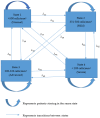A Multistate Continuous Time-Inhomogeneous Markov Model for Assessing the CD4 Count Dynamics of HIV/AIDS Patients Undergoing Antiretroviral Therapy in KwaZulu-Natal, South Africa
- PMID: 40566275
- PMCID: PMC12192621
- DOI: 10.3390/ijerph22060848
A Multistate Continuous Time-Inhomogeneous Markov Model for Assessing the CD4 Count Dynamics of HIV/AIDS Patients Undergoing Antiretroviral Therapy in KwaZulu-Natal, South Africa
Abstract
Monitoring CD4 count levels is essential for tracking the progression of HIV in patients. This study aimed to identify the key factors influencing HIV progression by incorporating time-varying factors and transition probabilities. The data for this study were obtained from the Centre for the AIDS Programme of Research in South Africa (CAPRISA), which enrolled 3325 patients aged 14 to 76 who initiated antiretroviral therapy (ART) and were followed up with between June 2004 and August 2013. The dataset included clinical, demographic, and treatment information to capture a comprehensive picture of HIV progression. To analyze the factors associated with HIV progression, this study employed time-inhomogeneous Markov models, which allow for incorporating covariates that change over time and transition probabilities. These models provided a robust framework to assess how various factors, such as CD4 count, viral load, and treatment adherence, evolve and influence disease progression. The results indicated that males had a significantly higher risk of moving from a normal (more than 500 cells/mm3) to mild state (351-500 cells/mm3) than females [HR: 1.614, 95% CI (1.281, 2.034)]. Rural patients had a significantly higher risk compared to urban patients of transiting from a mild state (351-500 cells/mm3) to an advanced state (200-350 cells/mm3) with a 95% confidence interval of (0.641, 1.009) [HR: 0.805, 95% CI (0.641, 1.009)]. The multistate model identified regimen, location, gender, and age as significant clinical variables influencing HIV progression. Rural patients and males showed slower transitions to CD4 count recovery. These findings provide valuable insights for disease management, treatment planning, and understanding the long-term prognosis for individuals living with HIV. Improving healthcare access, increasing educational efforts targeting men, reducing stigma, and fostering supportive environments can play a crucial role in enhancing CD4 count recovery and overall health outcomes for people living with HIV.
Keywords: CD4 count; multistate models; progression; transitions.
Conflict of interest statement
The authors declare no conflict of interest.
Figures
Similar articles
-
Abacavir-based triple nucleoside regimens for maintenance therapy in patients with HIV.Cochrane Database Syst Rev. 2013 Jun 5;2013(6):CD008270. doi: 10.1002/14651858.CD008270.pub2. Cochrane Database Syst Rev. 2013. PMID: 23740608 Free PMC article.
-
Effectiveness of antiretroviral therapy in HIV-infected children under 2 years of age.Cochrane Database Syst Rev. 2012 Jul 11;(7):CD004772. doi: 10.1002/14651858.CD004772.pub3. Cochrane Database Syst Rev. 2012. Update in: Cochrane Database Syst Rev. 2014 May 22;(5):CD004772. doi: 10.1002/14651858.CD004772.pub4. PMID: 22786492 Updated.
-
Optimal monitoring strategies for guiding when to switch first-line antiretroviral therapy regimens for treatment failure in adults and adolescents living with HIV in low-resource settings.Cochrane Database Syst Rev. 2010 Apr 14;(4):CD008494. doi: 10.1002/14651858.CD008494. Cochrane Database Syst Rev. 2010. PMID: 20393969
-
Prevalence of advanced HIV disease in sub-Saharan Africa: a multi-country analysis of nationally representative household surveys.Lancet Glob Health. 2025 Mar;13(3):e437-e446. doi: 10.1016/S2214-109X(24)00538-2. Lancet Glob Health. 2025. PMID: 40021302 Free PMC article.
-
Understanding Predictors of Lifelong Initiation and Follow-up Treatment for adolescents and youth living with HIV (UPLIFT): an integrated prospective cohort in Eastern Cape, South Africa.BMJ Open. 2025 Jul 8;15(7):e092909. doi: 10.1136/bmjopen-2024-092909. BMJ Open. 2025. PMID: 40633946 Free PMC article.
References
-
- UNAIDS . National Commitments and Policy Instrument 2022. Joint United Nations Programme on HIV/AIDS; Geneva, Switzerland: 2022. [(accessed on 6 July 2023)]. Available online: https://lawsandpolicies.unaids.org/
-
- Abdullahi H. Hematological Profile of HIV ART Naïve and HIV ART Experienced Individuals at the Aminu Kano Teaching Hospital North Western Nigeria. NISEB. 2016:1693–1698.
-
- Fauci A.S., Lane F.C. Human immunodeficiency virus (HIV) disease: AIDS and related disorders. In: Fauci B., Hauer K., Jamesons L., editors. Harrisons Principles of Internal Medicine. 16th ed. McGraw Hill; New York, NY, USA: 2005. pp. 1076–1139.
MeSH terms
Substances
Grants and funding
LinkOut - more resources
Full Text Sources
Medical
Research Materials


